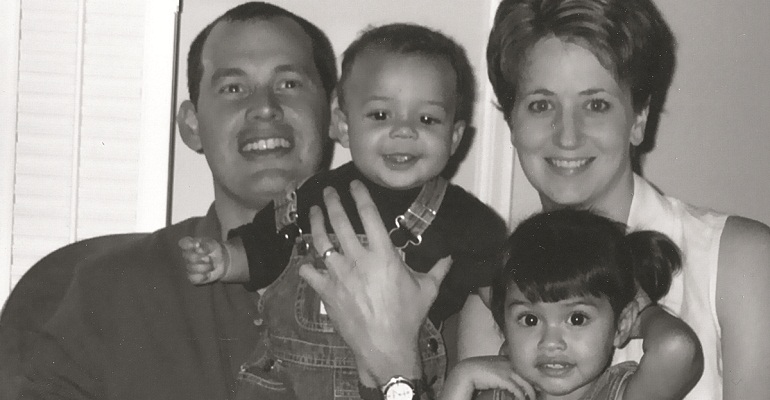The hospital room was finally quiet. My parents had just left, taking Natalie, our 15-month-old, to the hotel for a nap. Stephanie, my wife, slept in the chair beside me.
A few feet away, our son’s birth mother slept, too — a well-deserved rest after nearly 30 hours of labor and a cesarean section. In the stillness, I held our beautiful newborn son, Nathan. I thought about how blessed we had been. And then my mind went in another direction, recalling my struggle to accept a child of a different race and the faith that lead me to this point.
A Case of Cold Feet
A few summers ago, Stephanie and I were dangling at the end of our infertility rope and were not sure what to do next. We took a couple of months to deliberate and returned with a verdict: adoption.
Next we launched a massive education effort, starting with almost every adoption book in our local public library, and concluded that an independent, domestic adoption was right for us. We learned that the more kinds of adoptions we could open our hearts to, the less time we would be likely to wait for a placement.
As we considered what it might be like to adopt a child with a medical issue, one whose birth mother had a history of drug or alcohol abuse, or a child of another race, I grew increasingly scared. I’m not sure why, exactly, but I had a major case of cold feet.
I told my wife that I wanted a baby who was completely healthy and of the same race. It was not negotiable. I wanted a family, preferably two children. It was okay if they were adopted, but they had to look like me. My children had to be Caucasian.
Months passed. My closed-mindedness drove Stephanie crazy. I was terrified every time the phone rang. A phone call might mean a match, and that was the last thing I wanted, to be faced with the option of adopting transracially. The burden was so heavy that I met with a counselor, and then a priest, who put us in touch with an adoptive mother. She sent us a photo of four toddlers (including her daughter), all Caucasian/Hispanic.
Seeing these beautiful children was amazingly comforting. Now I could imagine that I might have a child who looked like they did. When The Call finally came, an attorney presented the possibility of a Caucasian/Hispanic baby. I said yes. For the first time in months, I shed the dead skin of fear. It felt so good to be free.
Our daughter, Natalie, was born two months after our match. Being a dad was better than I could ever have imagined. Stephanie and I had always wanted two children, so we began the process for our second adoption when Natalie was only six months old.
Once again, I pondered the racial make-up of our family. You might suppose that, with Natalie in our lives, my fears would have lessened. But instead, all the old apprehensions resurfaced. For the next couple of months, I thought and prayed about the issue of race.
I realized that I was more fearful about adopting a child of African-American heritage than I had been about adopting a child of Hispanic heritage. I remembered the difficult day-to-day experiences of my African-American college roommate, a young man who was made to feel uncomfortable in certain restaurants in our town. When I tried to reassure him by pointing out that I would be accompanying him, he replied, “You don’t understand.”
I worried that adopting an African-American child would throw me into the middle of something I don’t understand. My mind recited all of society’s prejudices and notions about difference. How could I make a path against these? At the same time, I felt a tug at my heart — a strong notion telling me to be open to an African-American/Caucasian baby. In the end, faith led me forward. Again, I said yes. And at about the same time, five states away, a child was conceived. My son.
Finally, a Family
Several months later, as I drove home from out-of-town business meetings, my cell phone rang. It was Stephanie, and she joyfully asked, “Do you want to be a dad again?” I knew that I did. Hearing that the baby was African-American/Caucasian, I felt that tug at my heart affirmed.
While I had been scared to death for most of the wait with Natalie’s birth mom, I was able to enjoy this one. We really got to know the birth mom, a young yet mature and loving person. At last the time came for us to travel seven hours to the hospital for the birth. As the nurse handed Nathan to Stephanie and me, his expression of contentment seemed to say, “I am home.”
Later, as I sat in the green vinyl hospital chair holding him, my mind filled with wonder. The last few years have been the hardest of my life, but they have also brought the greatest joy I’ve ever known. As I held Nathan, I could see the last piece of the puzzle being nudged into place. This baby, my son, was indeed home.



